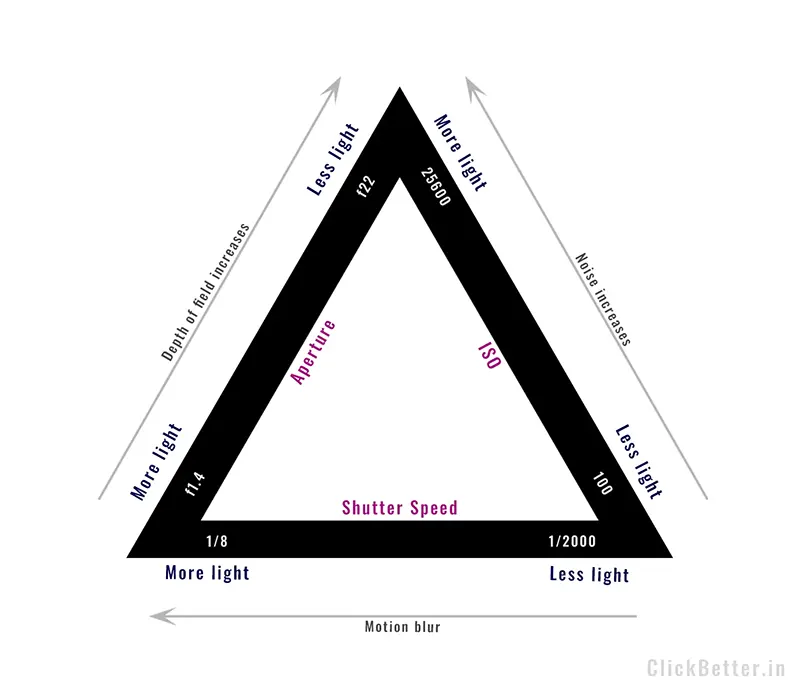The exposure triangle is a method of associating the three factors that determine the exposure of a photograph: aperture, shutter speed, and ISO. These three values have to be balanced to create a good picture. They not only affect exposure, but are also the largest determiners of the global appearance of an image; thus learning to balance them is crucial both for technique and composition.

There is no hard written rule for balancing the values of aperture, shutter and ISO to achieve a desired result. Only by practice one can achieve the method of balancing the values as per the scene they are working on.
The values of shutter, ISO and aperture are addressed in STOPS , and STOP values refer to the amount of change in light when the value of shutter, aperture and ISO changes.
What is STOPS
In photography a Stop is referred to the light reaching the camera sensor. So when light amount is said to be one Stop increased, means the amount of light is doubled. One Stop decrease means the amount of light is halved. Thus the amount of light multiplies or halves by change in stops.
For relating the exposure stops to Aperture, Shutter and ISO values we can refer to the below table. The stop change in Aperture, Shutter and ISO can be easily determined from the table.

In the above table , each of the values for Aperture, Shutter speed and ISO are shown in full stop variations. There are also half stops and ⅓ stops in the exposure scale. To simplify the exposure balancing technique for now we will consider only full Stop changes. Read more about Exposure STOPS.
Let’s look at some examples to understand this better:
- When the aperture value changes from 5.6 to 8, one full stop change happens in light. Here the amount of light will decrease.
- When the Shutter speed value changes from 1/125 to 1/500 one full change happens to light. Again here the light decreases with increase of shutter speed.
- In case of ISO value , when the value changes from say 800 to 400 it is considered as 1 full stop change in the amount of light.
Now let us make an assumption of a scene being photographed. We are keeping ISO at 400, f5.6 and shutter speed 1/125. But the picture seems to be under exposed, i.e. we need to increase the exposure. Here one of the below combinations of values can give you a brighter picture , considering the light in the scene does not change.
- We will increase the ISO to 800 and keep aperture at f5.6 and shutter at 1/125.
- We will decrease f5.6 to f4 and keep ISO at 400 and shutter at 1/125.
- We will decrease shutter speed to 1/60 and keep f5.6 and ISO 400.
Now we will explore balancing the exposure.Let us consider in the above scenario the image gets a good exposure output , and the image requirement changes :
- Balancing exposure with ISO and Aperture changes keeping the shutter constant: Assume that the picture has some grains at 800 ISO , so we cannot increase ISO. To remove grains we will decrease ISO to 400 and change f5.6 to f4 , keeping shutter at 1/125. Now if we reduce the ISO again to 200, the f4 will have to be changed to f2.8 , keeping shutter at 1/125.
- Balancing exposure with ISO and Shutter changes keeping Aperture constant: We are keeping the aperture value at f5.6 constant. Assume that the picture has a fast moving subject and at shutter 1/125 it is not possible to freeze the subject. So we will have to increase the shutter speed to 1/250, which will result in less light reaching the camera sensor. To compensate this we will have to increase the ISO from 800 to 1600.
- Balancing exposure with aperture and shutter changes keeping ISO constant: We will be keeping the ISO constant at 800. Assume that the picture needs more depth of field, i.e. we have to increase the aperture value to attain this. We will increase the aperture from f5.6 to f8 to achieve more depth of field, but will result in less light passing through the lens. To balance this we will reduce the shutter speed from 1/125 to 1/60.
Now in real world situations the exposure balancing technique is not limited to the above three. We can have different combinations of aperture, shutter speed and ISO values depending on the situation we are shooting. Practicing by taking pictures and making exposure variations is the best way to master it. Let’s start shooting !!
